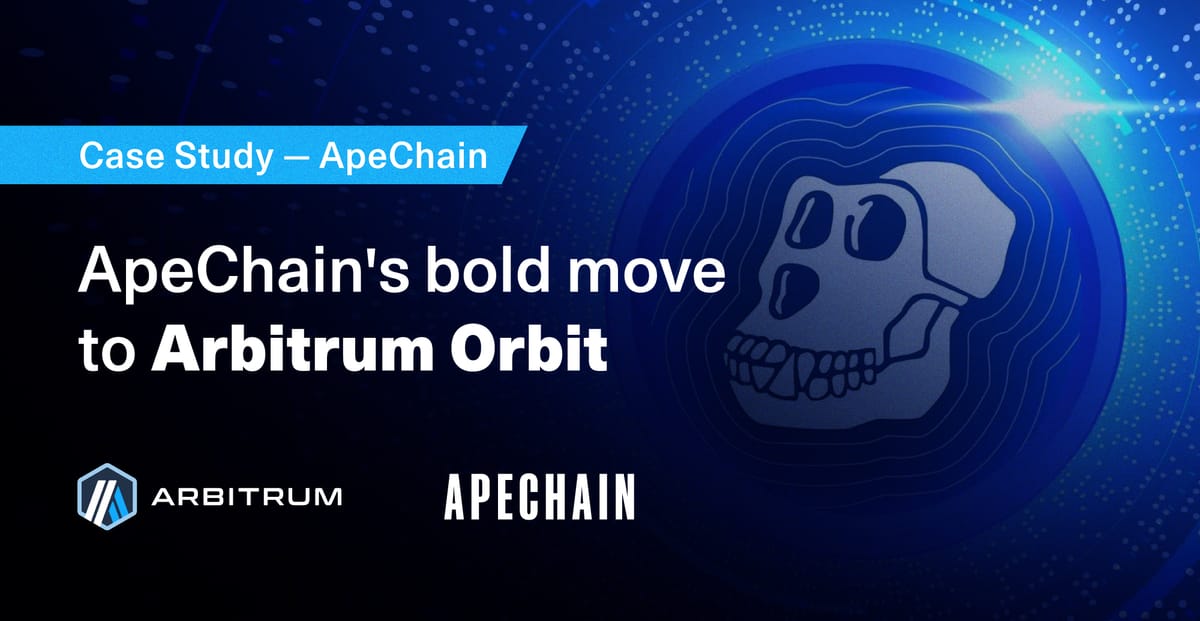ApeChain’s bold move to Arbitrum: A game-changing partnership

What is ApeChain?
ApeChain is a dedicated blockchain infrastructure layer designed to power the ApeCoin ecosystem, which includes a community of creators, developers, and users. The chain utilizes the $APE token as its native gas token and is designed to handle high transaction volumes, making it ideal NFTs, gaming, and other consumer-oriented use cases. The chain is designed to provide competitive platforms while enabling decentralized yield generation. At the same time, it prioritizes accessibility with features like fiat onramps, streamlined onboarding, and seamless cross-chain bridging with Ethereum, making it user-friendly for both developers and participants.
Case Study
Opportunity
The genesis of the ApeChain stemmed from the need for scalability and flexibility to support the expanding growth of the APE ecosystem. At the time, high-profile NFT launches by Yuga Labs saw a lot of interest, often leading to high gas prices, congestion on Ethereum and negative user experiences. An example is the Otherside NFT mint, where over $157 million worth of Ethereum was burned due to extraordinarily high gas fees. The sale involved minting virtual land NFTs, known as “Otherdeeds,” where many users overpaid to secure transactions or lost money on failed transactions, causing frustration within the community. This event underscored the scalability limitations of Ethereum during high-demand events and the critical need to find a more efficient, scalable solution to support their ambitious web3 projects.
In addition, there was no dedicated blockchain environment for ApeCoin and its builder community. This meant that developers who wanted to create applications or games using ApeCoin often faced logistical challenges, as the token’s liquidity was scattered across multiple platforms without a cohesive infrastructure for Web3 development. This, along with other challenges, presented a clear opportunity: to create a blockchain that could allow the Ape ecosystem to scale and unlock its full potential.
The Solution
To address these challenges, the ApeCoin DAO hosted an onchain vote, where DAO participants evaluated different scaling platforms, including blockchain solutions such as Polygon, Optimism and zkSync. The community ultimately voted in favor for ApeChain to be developed with Arbitrum technology and BD led by Horizen Labs, with 50% of community members voting for this solution. This decision was influenced by several key factors:
1. Customizable gas token
Arbitrum Orbit's flexibility in designing a tailored experience for builders, such as integrating exclusive tools and technologies, was an important factor in why DAO participants favored it. Orbit technology enabled ApeChain to implement unique governance models and use $APE as its native gas token, a feature not offered by other solutions.
2. Ethereum alignment
Arbitrum Orbit offered a layer-2 ecosystem that maintained Ethereum compatibility, ensuring ApeChain could leverage Ethereum’s security and infrastructure while operating on a scalable, fast chain.
3. Tooling advantages and a robust ecosystem
The integration with Arbitrum Orbit gave the ApeCoin DAO and ecosystem builders access to cutting-edge technologies and tools, which excited them. These included tools such as Stylus, which offers enhanced flexibility for game developers, allowing them to code in languages such as Rust and C++.
Additionally, ApeCoin was integrated with LayerZero, allowing seamless movement of assets between blockchains. At launch, ApeChain was equipped with the best-in-class infrastructure support, including:
- Alchemy and Nirvana for RPC Services
- Pyth Network for Oracle Solutions
- Etherscan for block explorer functionality
- Goldsky and Covalent for indexing
This meant community projects on ApeChain were equipped with strong tooling from the start and could emerge as success stories quickly. An example is ApeExpress, a meme coin launchpad powered by Camelot. In just 24 hours after launch, 55 meme coins graduated from the bonding curve, seven of which reached a multi-million dollar market cap.
4. Unparalleled speed
Orbit chains can achieve block speeds as low as 100 milliseconds. Additionally, Orbit chains with low activity can achieve rapid finality without incurring higher batch posting costs by sharing and amortizing these costs with traffic on Arbitrum One.
Performance and Growth
Since its launch in October 2024, ApeChain has already demonstrated promising traction. It currently has over 60 applications and integrations deployed across infrastructure, gaming, and DeFi. Prominent projects on the chain include Top Trader, a high-level trading platform, Otherside, a world-building platform offering an engaging space to create, play, compete, connect, and explore collaboratively and Banana Bill, a fun and interactive DeFi rewards system designed to incentivize community engagement.
By aligning with Ethereum while harnessing Arbitrum's technical innovations, ApeChain has established itself as a robust foundation for the ApeCoin DAO's ambitious vision. With continuous improvements in its growing ecosystem, ApeChain is poised to redefine how decentralized communities thrive in web3.
